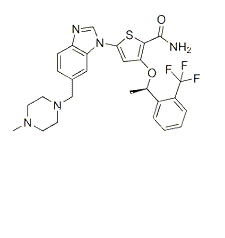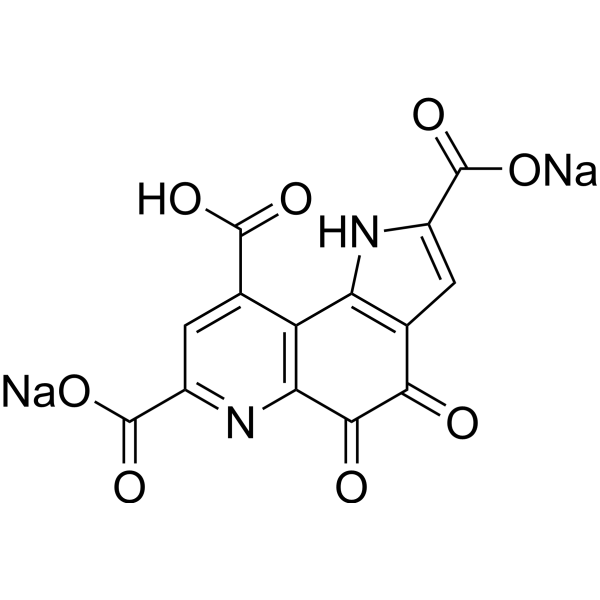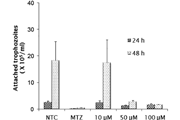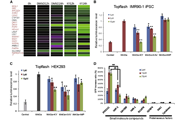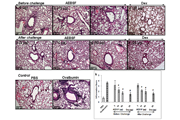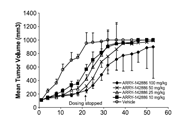-
生物活性
GSK461364 isa potent, selective, reversible, ATP-competitive Plk1 inhibitor that inhibitsthe proliferation of multiple human cancer cell lines by promoting G2/M cellcycle arrest at low concentrations. GSK461364 inhibits purified Plk1 with Ki of 2.2 nM in a cell-free assay. It is more than 1000-fold selective against Plk2/3.
Enzyme activities of GSK461364

Growthinhibition (GI50/nM) of GSK461364[1]

-
体外研究
-
体内研究
-
激酶实验
Enzyme assays[1]
Kinase reactions were performed in a finalassay volume of 10μL using the Z’-Lyte Assay kit (Ser/Thr peptide 16). Briefly, reactionscontained 50mmol/L HEPES (pH 7.5), 10mmol/L MgCl2, 1mmol/L EGTA,1mmol/L DTT, 0.01% Brij 35, 0.01mg/mL casein, 200μmol/L ATP, 200μmol/LPolo Box peptide (NH2-MAGPMQS[pT]PLNGAKK-OH), and 6nmol/L recombinantPlk1(H6-tev-PLK 1-603). Plk1was preincubated for 60 min in the presence or absenceof 0 to 1,000nmol/L GSK461364A. Reactions were then initiated by the additionof 2μmol/L peptide. After 15 min at 23 ℃, reactions werequenched and processed according the Z’-Lyte protocol and read on an EnVisionplate reader. Raw fluorescence values were converted to concentration ofproduct formed using substrate and product standards. IC50 values weredetermined using two-parameter fit (Hill coefficient and IC50) using GraFitsoftware. Because the potency of inhibition for GSK461364A was observed to varyas a function of the ATP concentration in a manner consistent with anATP-competitive mode of inhibition, an upper limit for the Ki*app for GSK461364Awas determined by applying the Cheng-Prusoff relationship for a competitiveinhibitor (ATP Km*app = 16μmol/L) to the IC50 value obtained with 60min preincubation ofGSK461364A.

-
细胞实验
Cell lines[3]
Three OS cell lines, U2OS, MG63 and SJSAwere selected for in vitro study and maintained in either Dulbecco's modifiedEagle's medium (DMEM), Iscove's modified Dulbecco's medium, or DMEM/F12 basemedia with 10% fetal bovine serum.
Cellviability assay
TACS™3-(4,5-dimethylthiazol-2-yl)-2,5-diphenyltetrazolium bromide (MTT) cellproliferation assay was used in the cell viability assay. Approximately 2,000-20,000cells/100μl/wellwere seeded in 96-well plates overnight. Subsequently, reagents at differentconcentrations desired time at 37˚C, pulsed with 10μl MTT reagent, and incubatedfor an additional 4h at 37 ˚C. Furthermore, detergent reagent of 100μl/well wasadded and mixed thoroughly to dissolve the blue crystals. Absorbance of theconverted dye was measured using a Vmax microplate reader at 570 nm (test) and650nm wavelengths. Cell survival was calculated using the following equation: %survival = (mean experimental absorbance/mean control absorbance) x 100. Thepossible synergistic effect of GSK461364 and chemotherapy was measured usingthe combination index (CI) calculated using CalcuSyn software. CI >1 wasdefined as antagonism, CI = 1 as additivity, and CI <1 as synergy; theexperiment was performed in triplicate.

-
动物实验
Xenograft model[4]
SK-N-AS and IMR32 neuroblastoma cells were culturedto 80% confluency, harvested and suspended in 200μL Matrigel™ for subcutaneousinoculation of 2 × 107 cells into the left flank of 8-week-oldfemale athymic nu/ nu mice (n = 12 mice). Mice were randomly assigned (6 miceper group) to either GSK461364 or vehicle (0.1% DMSO, 5% glucose) controlgroups after tumors reached 200 mm3. Vehicle control or 50mg GSK461364per kg body weight was intraperitoneally injected every second day until allcontrol mice reached the endpoint (tumor volume of 2,500mm3) but notlonger than 40 days. Tumor growth was monitored using a caliper, and tumorvolume was calculated using the formula, (breadth × length ×height)/2. Micewere euthanized by cervical dislocation when tumor size exceeded 2,500mm3.In mice, whose xenograft tumors were to be immunohistologically examined forapoptosis and proliferation, 2 doses of 100 mg GSK461364 per kg body weightwere administered every 12 hours over a 3-day course (n = 3 mice in bothGSK461364 and vehicle control groups). Mice were euthanized 4 hours after thelast treatment injection, and xenograft tumors were excised, formalinfixed and paraffin-embedded.

-
不同实验动物依据体表面积的等效剂量转换表(数据来源于FDA指南)
|  动物 A (mg/kg) = 动物 B (mg/kg)×动物 B的Km系数/动物 A的Km系数 |
|
例如,已知某工具药用于小鼠的剂量为88 mg/kg , 则用于大鼠的剂量换算方法:将88 mg/kg 乘以小鼠的Km系数(3),再除以大鼠的Km系数(6),得到该药物用于大鼠的等效剂量44 mg/kg。
-
参考文献
[1] Gilmartin AG, Bleam MR, Richter MC, et al. Distinct concentration-dependent effects of the polo-like kinase 1-specific inhibitor GSK461364A, including differential effect on apoptosis. Cancer Res. 2009;69(17):6969-6977.
[2] Ferrarotto R, Goonatilake R, Young Yoo S, et al. Epithelial-Mesenchymal Transition Predicts Polo-Like Kinase 1 Inhibitor-Mediated Apoptosis in Non-Small Cell Lung Cancer. Clin Cancer Res. 2016;22(7):1674-1686.
[more]
分子式
C27H28F3N5O2S |
分子量
543.6 |
CAS号
929095-18-1 |
储存方式
﹣20 ℃冷藏长期储存。冰袋运输 |
溶剂(常温)
|
DMSO
10 mg/mL |
Water
<1 mg/mL |
Ethanol
30 mg/mL |
体内溶解度
-
Clinical Trial Information ( data from http://clinicaltrials.gov )
| NCT Number | Conditions | Interventions | Sponsor/Collaborators | Phases | Start Date | Last Updated |
| NCT00536835 | Lymphoma, Non-Hodgkin | Drug: GSK461364 | GlaxoSmithKline | Phase 1 | 2007-08-01 | 2016-10-11 |
注:以上所有数据均来自公开文献,并不保证对所有实验均有效,数据仅供参考。
-
相关化合物库
-
使用AMQUAR产品发表文献后请联系我们





